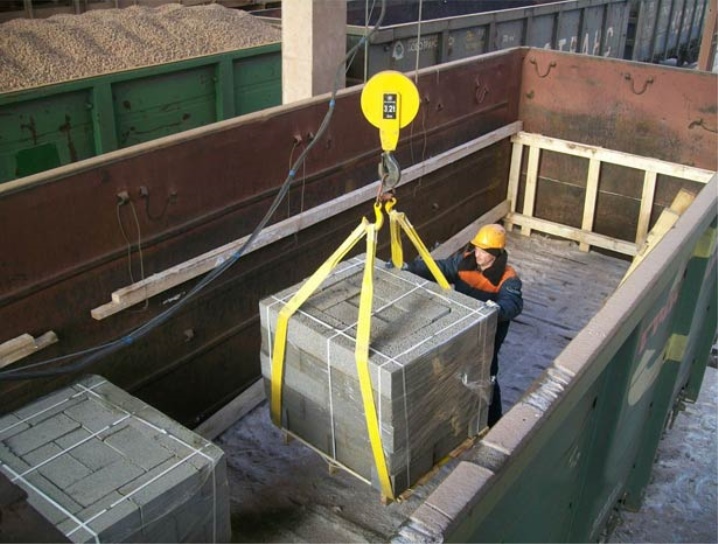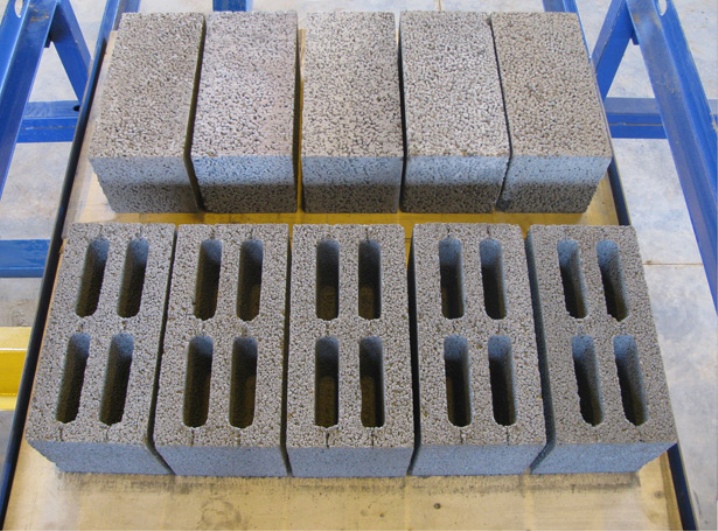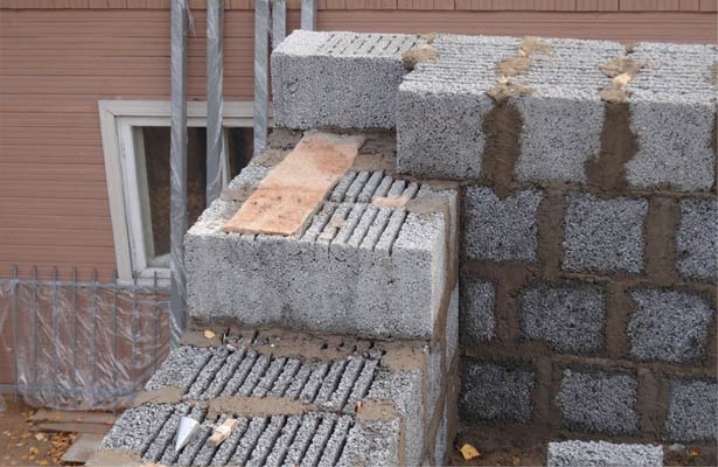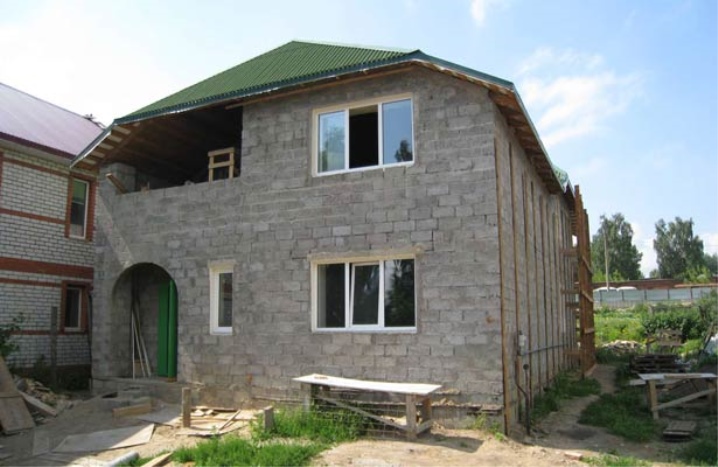Expanded clay - the main characteristics

Expanded clay - a kind of lightweight concrete, the main filler of which - expanded clay.
Obtained by special roasting of clay, expanded clay has a porous structure. Because of this, concrete blocks are relatively light, but strong enough. They are mainly used for the construction of lightweight structures with a good margin of safety.
Composition and proportions
The main ingredients of claydite concrete are: expanded clay (60%), cement (10%), quartz sand (30%). You will also need water to mix the solution. Sometimes plasticizers or special air-entraining additives are added, for example, saponified wood resin.
Expanded clay fraction usually 5-10 mm. The smaller it is, the higher the strength of the blocks and the greater the weight.Therefore, this material has several classifications, for example, by strength or thermal conductivity.
It is best to buy ready-made factory blocks. They are made according to certain SNIPs and GOSTs, have a strict proportion, the mixture itself is thoroughly mixed with special equipment, and then formed into blocks by the method of volumetric vibropressing.
Do it yourself
But it is possible to make independently with your own hands both individual blocks and a monolithic construction.
To do this, all parts of the claydite concrete ingredients must be loaded into the concrete mixer in the following order:
- water,
- expanded clay
- cement,
- sand.
Typically, water is 8-10%, but the humidity of the claydite itself should be taken into account. If he was on the street or was previously wetted for better adhesion, then less water would be needed than for pellets stored in a dry room.
The amount of water should be taken seriously. If it is not enough, the claydite will absorb it, and the mixture itself will turn out to be dry and crumbling.
In this case, water is added gradually to the desired consistency. If it is too much, the solution will be very liquid. In this case, you need to give him a little rest.“Crude” keramzitbeton should be of a consistency such that it can be taken by hand, and all the granules are coated with cement mortar.
In addition to the concrete mixer, you will need a vibrating machine.
It is necessary to place a steel plate in the molding and fill it with a mixture. After the finished unit dried for 2-3 days. But ideally, you need to give rest for about a week. If the blocks are dried in the street in the heat, they should be sprinkled with water from drying out.
Steel plates are removed from the already finished dried block. They will gain brand strength only in 30 days with regular moistening. The standard form takes 10-11 liters of the mixture.
Classification
The main classification is by purpose.
There are types:
- constructive - used for the construction of bridges, supporting structures of buildings, racks, etc .;
- constructive heat-insulating - mainly used in the construction of walls;
- thermal insulation - mostly go as insulation.
They are also distinguished by their use (partition and wall), size and shape.
The latter can be solid (monolithic) and hollow, in which there can be deaf and through-holes.
Dimensions
Partitioning and wall blocks of claydite concrete vary in size. But both are governed by GOST 6133-99.
Wall have dimensions:
- 390x190x188 mm
- 288x288x138 mm
- 288x138x138 mm
- 190x190x188 mm
- 90x190x188 mm.
The weight of corpulent reaches 26 kg. Hollow (slotted) is slightly lighter, about 17 kg.
Sizes of partition:
- 590x90x188 mm
- 390x90x188 mm
- 190x90x188 mm.
Its thickness is only 90 mm. Weight ranges from 7 to 14 kg (for hollow and corpulent, respectively).
But almost any manufacturer can supply blocks of expanded clay of non-standard sizes to order.
Specifications
Expanded clay blocks have a number of characteristicswhose indicators can differ dramatically from each other depending on the type and size of the blocks, as well as the presence of certain additives in them:
- Strength. The smallest values of the insulation blocks (from 5 to 25 kg / cm2). The highest in constructive (from 100 to 500 kg / cm2). All intermediate indicators (from 25 to 100 kg / cm2) for structurally insulating.
- Thermal conductivity. According to thermal conductivity, keramsit concrete blocks can be compared with wood. And the less cement in the composition, the lower the thermal conductivity. But even heavy constructive ones are preferable to brick and ordinary concrete.If the construction of a residential house to use hollow blocks, it will be much warmer. Typically, its rate ranges from 0.14 to 0.66 W / m * K.
- Frost resistance. The smaller the porosity of the material, the higher its value. So, in constructive frost resistance up to 500 cycles, in constructive heat-insulating - 150, in heat-insulating - 15-50.
- Soundproofing. The higher the porosity of expanded clay, the better sound insulation. For example, blocks of 590x90x188 mm in size, folded into the partition, provide sound insulation up to 45-50 dB.
- Vapor permeability Thermal insulating have a higher vapor permeability (up to 9 mg / m * h * Pa) compared with constructive (3 mg / m * h * Pa).
- Water absorption. For clay blocks, this value is 5-10% by weight, but can be reduced by the addition of plasticizers.
- Shrinkage. It gives the same shrinkage as heavy concrete, namely 0.3-0.5 mm / m.
- The maximum number of floors of buildings. Structurally-insulating blocks are preferably used for low-rise buildings. But the building blocks allow you to build buildings of 10-12 floors.
On the features, characteristics and application of different types of clay blocks, watch the following video from the channel ForumHouseTV. Learn a lot of interesting things.
Houses
Advantages of building houses from expanded clay blocks:
- As a material for individual construction clay blocks are just perfect. They perfectly retain heat, practically do not absorb moisture, because of what they do not freeze through, perfectly protect from street noise, fire-resistant. Due to its size, masonry is much faster than brick. The only drawback - the blocks do not always fit each other in size.
- The financial side of such construction is also pleasant. Firstly, the material itself is inexpensive. Secondly, it allows saving on insulation, since it has a low thermal conductivity. Thirdly, due to its light weight does not require a solid foundation, on which you can also save. But claydite is used only in the construction of walls. It is not suitable for casting the base, since it does not have sufficient strength for this.
- And because of almost insignificant shrinkage in the future, it will not be necessary to spend extra money on repairs to the interior of the rooms.
Thanks to all these advantages, claystone blocks are very popular in Europe. But in Russia they are no less in demand.This is a great budget option. An analogue may be a house of foam blocks.
Any construction begins with the development of a project for a house and a work plan.
Think over the following nuances:
- Select the type of foundation. If the basement is not provided, then you can stay on the strip foundation. Once the foundation is strong and shrinks, you can begin to build walls.
- Lay blocks of expanded clay as well as brick. But here it is important to observe the same thickness of the solution between the blocks. No drops, cracks and voids. All defects are eliminated immediately as they arise.
- For a comfortable stay in the house, the wall thickness should be at least 40 cm. Otherwise, additional thermal insulation is required. In addition, over time, the design still slightly loses its ability to keep heat at the proper level, which will affect the increase in heating costs. Therefore, additional insulation never hurts, but it is better to place it outside.
Thermal insulation
To increase the insulation in the following ways:
- It is possible to make facing of claydite-concrete blocks, but this method is expensive and rarely used.
- More affordable option - mineral wool. It is laid in 2 layers, with a layer of waterproofing between them. Foil can be used for vapor permeable insulation.
- Even as a heater (both on the outside and on the inside) fiberglass can be used. But to work with it you will need a respirator and protective gloves.
- If the choice is made in favor of the foam, then you should choose with a higher vapor-tightness. But it is important to remember that he is very fond of mice and other small rodents, and therefore must be immured in concrete.
Facing
External facing of claydite concrete walls can be made from:
- bricks
- use facade plaster,
- thermopanels,
- close the siding.
On the benefits of expanded clay in the construction of the house, watch the following video channel "Square meter".
Stamps and prices
The strength of clay blocks depends on their density, so the price of blocks with higher density is higher.
The higher the mark of the block, the higher its density:
- Stamps 50-100 M are used mainly for thermal insulation purposes.
- For the construction of buildings using the brand 150-200 M.
- Stamps above 300 M are already used for the construction of various structures, for example, bridges and highways.
The price of clay blocks varies depending on the size, shape (solid or hollow) and brand. On average, in the regions 1 wall block costs from 30 to 60 rubles, a partition wall - 20-40 rubles.
When calculating the cost of all the material must be considered the cost of delivery. In addition, all units are transported in special pallets. If the packaging is returnable, then a pledge is taken for it. If not, then the cost of one pallet can range from 100 to 300 rubles.

























